Complete Solutions to Single Correct of chapter WORK, POWER & ENERGY of Class 11 book with complete answers and questions
| Class 11 | PHYSICS |
| Chapter | WORK, POWER & ENERGY |
| CENGAGE PHYSICS | Single Correct |
| Number Of Questions | 100 |
| Academic Year | 2023-24 |
The displacement `x` of particle moving in one dimension, under the action of a constant force is related to the time `t` by the equation ` t = sqrt(x) +3`
where `x is in meters and t in seconds` . Find
(i) The displacement of the particle when its velocity is zero , and
(ii) The work done by the force in the first ` 6 seconds`.04:13View SolutionA mass M is lowered with the help of a string by a distance h at a distance acceleration `g//2`. The work done by the string will be
01:26View SolutionA force of `vecF=2xhati+2hatj+3z^2hatk N` is acting on a particle. Find the work done by this force in displacing the body from `(1, 2, 3)m` to `(3, 6, 1)m`.
02:16View SolutionTwo identical `5kg` blocks are moving with same speed of `2ms^-1` towards each other along a frictionless horizontal surface. The two blocks collide, stick together, and come to rest. Consider the two blocks as a system. The works done by external and internal forces are, respectively,
02:24View SolutionIf we shift a body in equilibrium from A to C in a gravitational field via path AC or ABC,
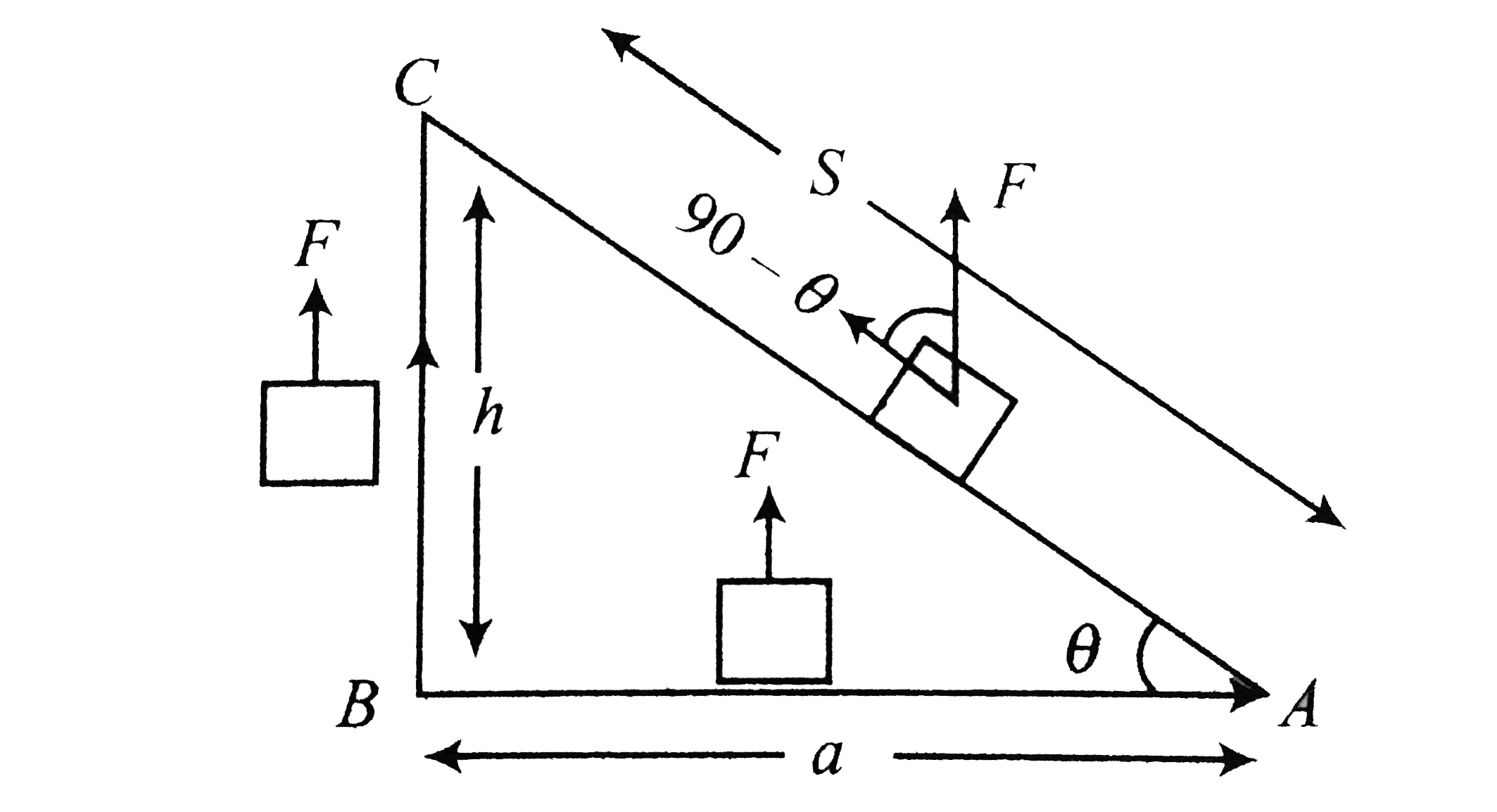 01:46View Solution
01:46View SolutionIn which of the following cases can the work done increase the potential energy?
01:12View SolutionWork done by the conservative force on a system is equal to :
01:30View SolutionWhich of the following statements is correct?
03:31View SolutionA man `M_(1)` of mass `80 kg` runs up a staircase in `15 s`. Another man `M_(2)` also of mass `80 kg` runs up the same staircase in `20 s`. The ratio of the power development by then will be:
01:37View SolutionAn engine pumps up `100 kg` water through a height of `10 m` in `5 s`. If efficiency of the engine is `60%`. What is the power of the engine? `Take g = 10 ms^(2)`.
02:11View SolutionA pump motor is used to deliver water at a certain rate from a given pipe. To obtain 'n' times water from the same pipe in the same time by what amount (a) the force and (b) power of the motor should be increased ?
03:55View SolutionAn engine pumps water continously through a hose. Water leave the hose with a velocity `v` and `m` is the mass per unit length of the Water jet. What is the rate at Which kinetic energy is imparted to water?
01:42View SolutionA bus can be stopped by applying a retarding force F when it is moving with speed v on a level road. The distance covered by it before coming to rest is `s`. If the load of the bus increase by 50% because of passengers, for the same speed and same retarding force, the distance covered by the bus to come to rest shall be
02:30View SolutionA heavy weight is suspended from a spring . A person raises the weight till the spring becomes slack . The done by him is `W`. The energy stored in the stretched spring was `E` . What will be the gain in gravitational potential energy?
02:16View SolutionThe speed v reached by a car of mass m in travelling a distance x, driven with constant power P, is given by
01:33View SolutionPower supplied to a mass `2 kg` varies with time as `P = (3t^(2))/(2)` watt. Here `t` is in second . If velocity of particle at `t = 0 is v = 0`, the velocity of particle at time `t = 2s` will be:
02:48View SolutionVelocity-time graph of a particle moving in a straight line is as shown in figure. Mass of the particle is 2 kg. Work done by all the forces acting on the particle in time interval between t = 0 to t = 10 s is
 02:47View Solution
02:47View SolutionA body is moved along a straight line by a machine delivering constant power. The distance moved by the body in time t is proportional to
03:53View SolutionA car drives along a straight level frictionless road by an engine delivering constant power. Then velocity is directly proportional to
01:45View SolutionFigure shows the vertical section of a frictionless surface. A block of mass `2kg` is released from rest from position A, its KE as it reaches position C is (`g=10ms^-2`)
 01:56View Solution
01:56View SolutionThe kinetic energy K of a particle moving along a circle of radius R depends upon the distance s as `K=as^2`. The force acting on the particle is
04:29View SolutionA particle of mass in is moving in a circular with of constant radius `r` such that its contripetal accelenation `a_(c) ` is varying with time `t` as `a_(c) = K^(2) rt^(2)` where K` is a constant . The power delivered to the particles by the force action on it is
02:19View SolutionAn object of mass m slides down a hill of height h of arbitrary shape and after travelling a certain horizontal path stops because of friction. The friction coefficient is different for different segments for the entire path but is independent of the velocity and direction of motion. The work that a force must perform to return the object to its initial position along the same path is
02:48View SolutionA toy gun a spring of force constant `k`. When changed before being triggered in the upward direction, the spring is compressed by a distance `x`. If the mass of the shot is `m`, on the being triggered it will go up to a height of
02:06View SolutionA block of `4kg` mass starts at rest and slides a distance `d` down a friction less incline ( angle `30^@`) where it runs into a spring of negligible mass. The block slides an additional `25cm` before it is brought to rest momentarily by compressing the spring. The force constant of the spring is `400Nm^-1`. The value of `d` is (take `g=10ms^-2`)
 04:02View Solution
04:02View SolutionFigure shows a plot of the conservative force F in a unidimensional field. The plot representing the function corresponding to the potential energy (U) in the field is
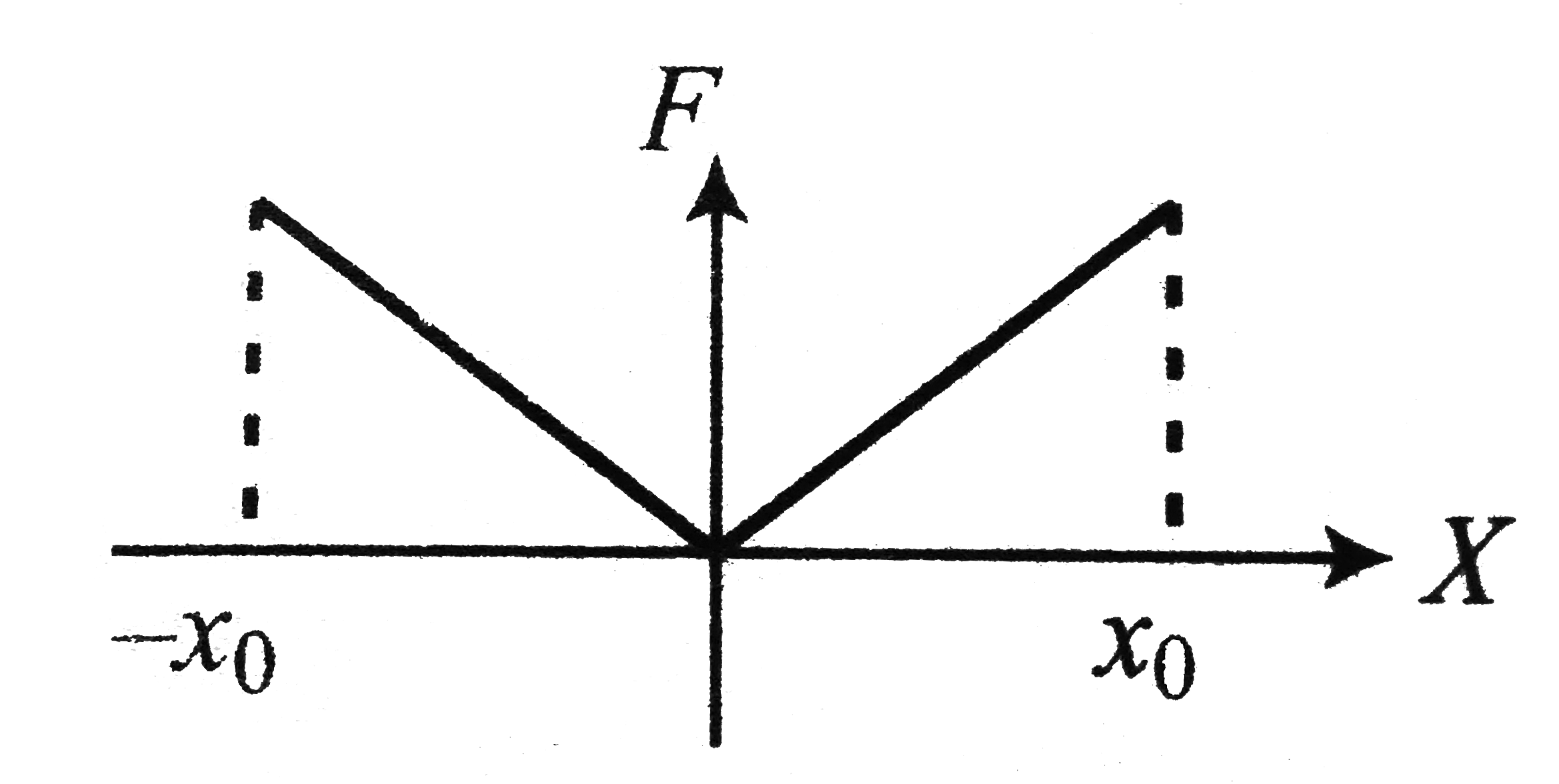 03:28View Solution
03:28View SolutionA spring is compressed between two toy carts to masses `m_1` and `m_2`. When the toy carts are released, the spring exerts on each toy cart equal and opposite forces for the same small time t. If the coefficients of friction `mu` between the ground and the toy carts are equal, then the magnitude of displacements of the toy carts are in the ratio
03:38View SolutionA massless platform is kept on a light 0.1 kg elastic spring, as shown in the figure When particle of mass 0.1 kg is dropped on the pan from a height of 0.24 m, the particle strikes the pan, and the spring is compressed by 0.01 m. From what height should the particle be dropped to cause a compression of 0.04 m ?
 05:14View Solution
05:14View SolutionA partical is realeased from the top of two inclined rought surface of height `h` each. The angle of inclination of the two planes are `30^(@)` and `60^(@)` respectively. All other factors (e.g. coefficient of friction , mass of the block etc) are same in both the cases. Let `K_(1) and K_(2)` be the kinetic energy of the partical at the bottom of the plane in two cases. Then
05:02View SolutionSystem shown in figure is released from rest. Pulley and spring is massless and friction is absent everywhere. The speed of 5 kg block when 2 kg block leaves contact with ground is (Take froce constant of spring k = 40 N/m and `g = 10 m//s^(2)`)
 04:10View Solution
04:10View SolutionWhen a person stands on a weighing balance, working on the principle of Hooke's law, it shows a reading of `60kg` after a long time and the spring gets compressed by `2.5cm`. If the person jumps on the balance from a height of `10cm`, the maximum reading of the balance will be
04:33View SolutionA particle of mass `m` is projected at an angle `alpha` to the horizontal with an initial velocity `u`. The work done by gravity during the time it reaches its highest point is
01:26View SolutionIn the above question, the average power delivered by gravity is
02:07View SolutionA person of mass `70kg` jumps from a stationary helicopter with the parachute open. As he falls through `50m` height, he gains a speed of `20ms^-1`. The work done by the viscous air drag is
02:32View SolutionA particle located in a one-dimensional potential field has its potential energy function as `U(x)(a)/(x^4)-(b)/(x^2)`, where a and b are positive constants. The position of equilibrium x corresponds to
02:28View SolutionA large slab of mass `5kg` lies on a smooth horizontal surface, with a block of mass `4kg` lying on the top of it. The coefficient of friction between the block and the slab is `0.25`. If the block is pulled horizontally by a force of F `=6N`, the work done by the force of friction on the slab, between the instants `t=2s` and `t=3s`, is `(g=10ms^-2)`
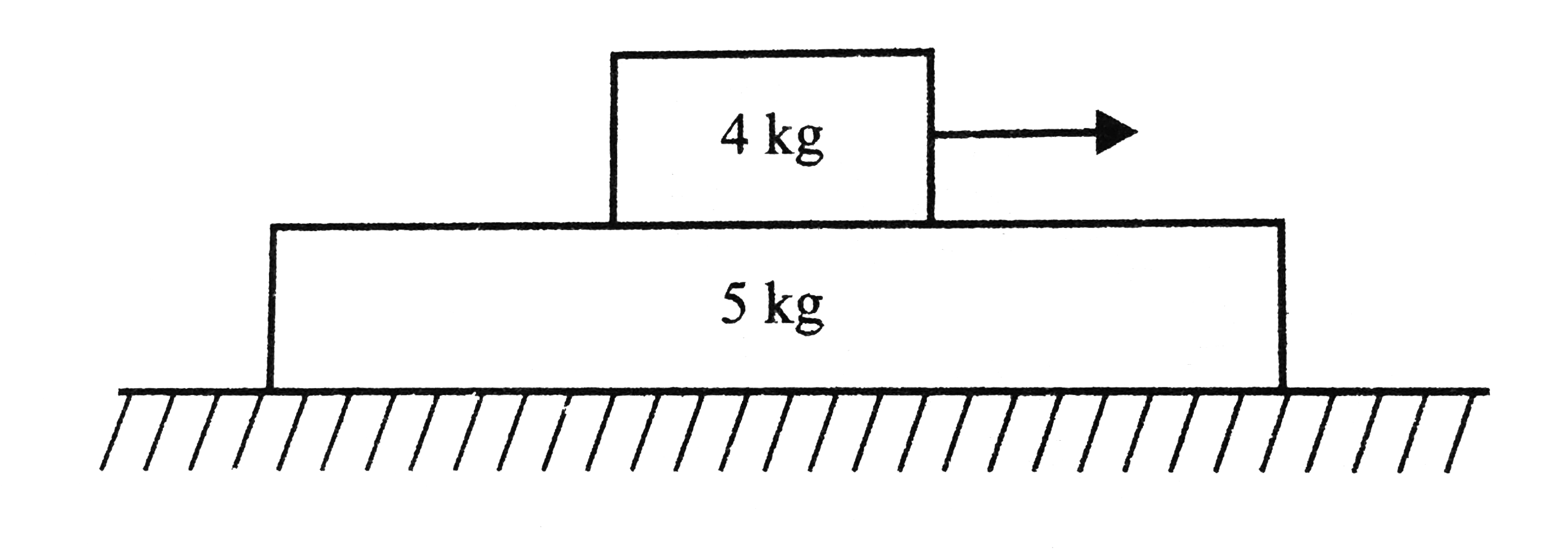 04:56View Solution
04:56View SolutionA small block of mass `2kg` is kept on a rough inclined surface of inclination `theta=30^@` fixed in a lift. The lift goes up with a uniform speed of `1ms^-1` and the block does not slide relative to the inclined surface. The work done by the force of friction on the block in a time interval of `2s` is
02:44View SolutionA particle of mass m moves on a straight line with its velocity varying with the distance travelled according to the equation `v=asqrtx`, where a is a constant. Find the total work done by all the forces during a displacement from `x=0 to x=d`.
03:03View SolutionA particle of mass m moves along a circular path of radius r with a centripetal acceleration `a_n` changing with time t as `a_n=kt^2`, where k is a positive constant. The average power developed by all the forces acting on the particle during the first `t_0` seconds is
02:19View SolutionA chain of length l and mass m lies of the surface of a smooth hemisphere of radius `Rgtl` with one end tied to the top of the hemisphere. Taking base of the hemisphere as reference line, find the gravitational potential energy of the chain.
 05:37View Solution
05:37View SolutionTwo discs, each having mass `m`, are attached rigidly to the ends of a vertical spring. One of the discs rests on a horizontal surface and the other produces a compression `x_0` on the spring when it is in equilibrium. How much further must the spring be compressed so that when the force causing compression is removed, the extension of the spring will be able to lift the lower disc off the table?
 05:13View Solution
05:13View SolutionTwo ends A and B of a smooth chain of mass `m` and length `l` are situated as shown in figure. If an external agent pulls A till it comes to same level of B, work done by external agent is
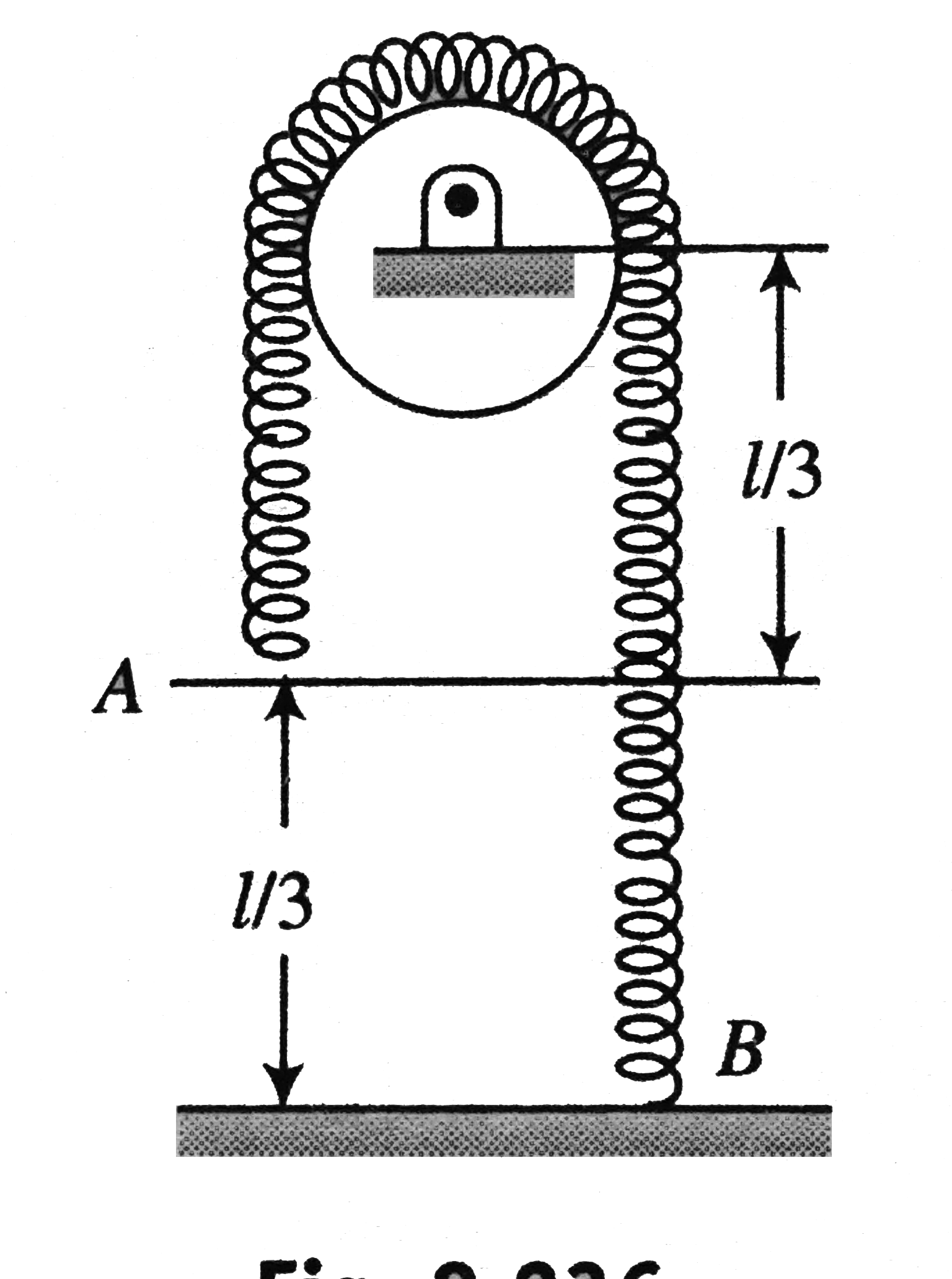 07:12View Solution
07:12View SolutionA block `m` is kept stationary on the surface of an accelerating cage as shown in figure. At the given instant, study the following statetments regarding the block.
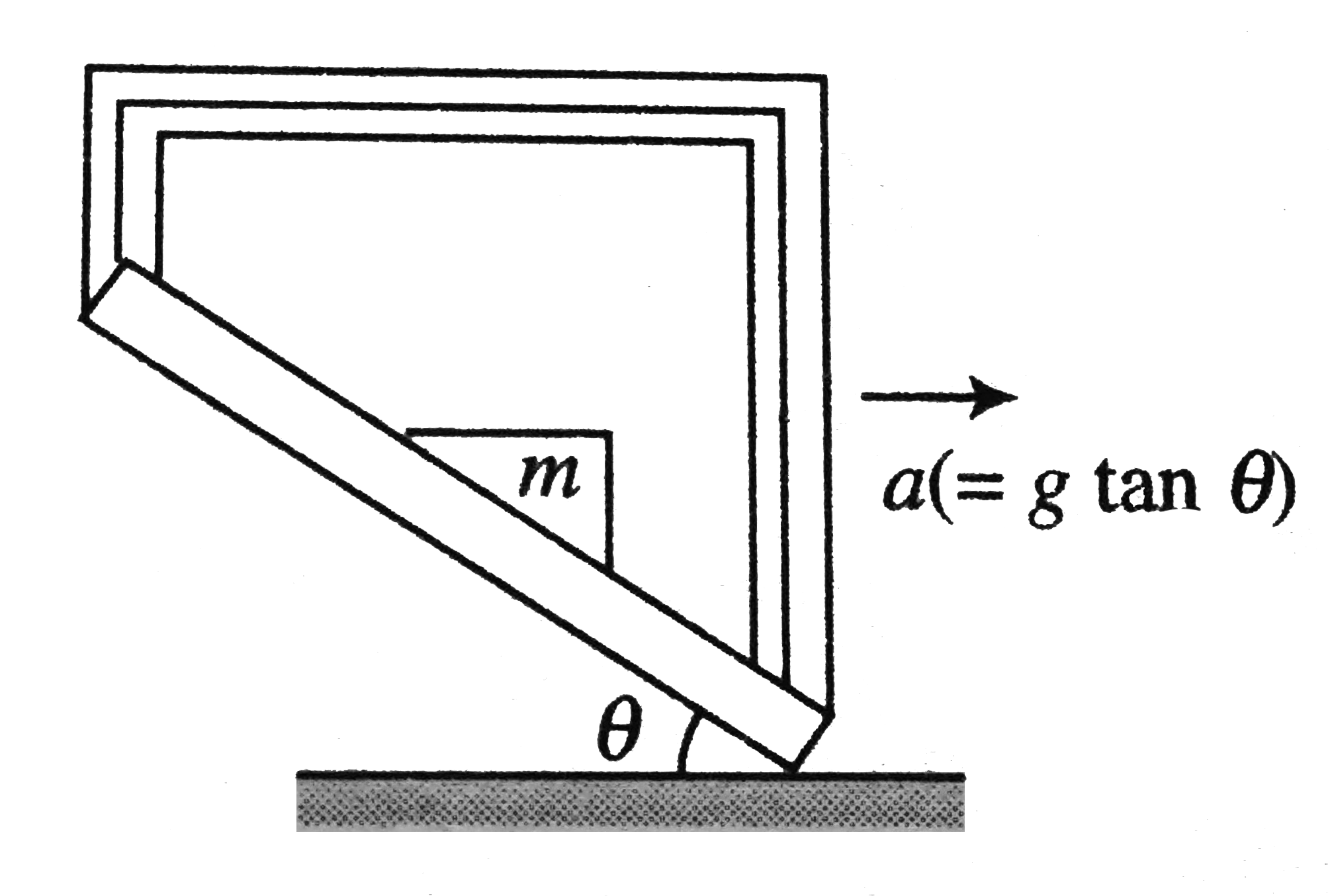
i. Normal reaction performs positive work on the block.
ii. Frictional work done on the block is negative.
iii. No net work is done by normal reaction and friction on the block.
Now mark the correct answer.02:47View SolutionA man places a chain (of mass `m` and length `l`) on a table slowly. Initially, the lower end of the chain just touches the table. The main brings down the chain by length `l//2`. Work done by the man in this process is
01:46View SolutionThe potential energy of a particle of mass m is given by `U=(1)/(2)kx^(2)` for `x lt 0` and U = 0 for `x ge 0`. If total mechanical energy of the particle is E. Then its speed at `x = sqrt((2E)/(k))` is
01:47View SolutionThe blocks A and B shown in figure have masses `M_A=5kg` and `M_B=4kg`. The system is released from rest. The speed of B after A has travelled a distance `1m` along the incline is
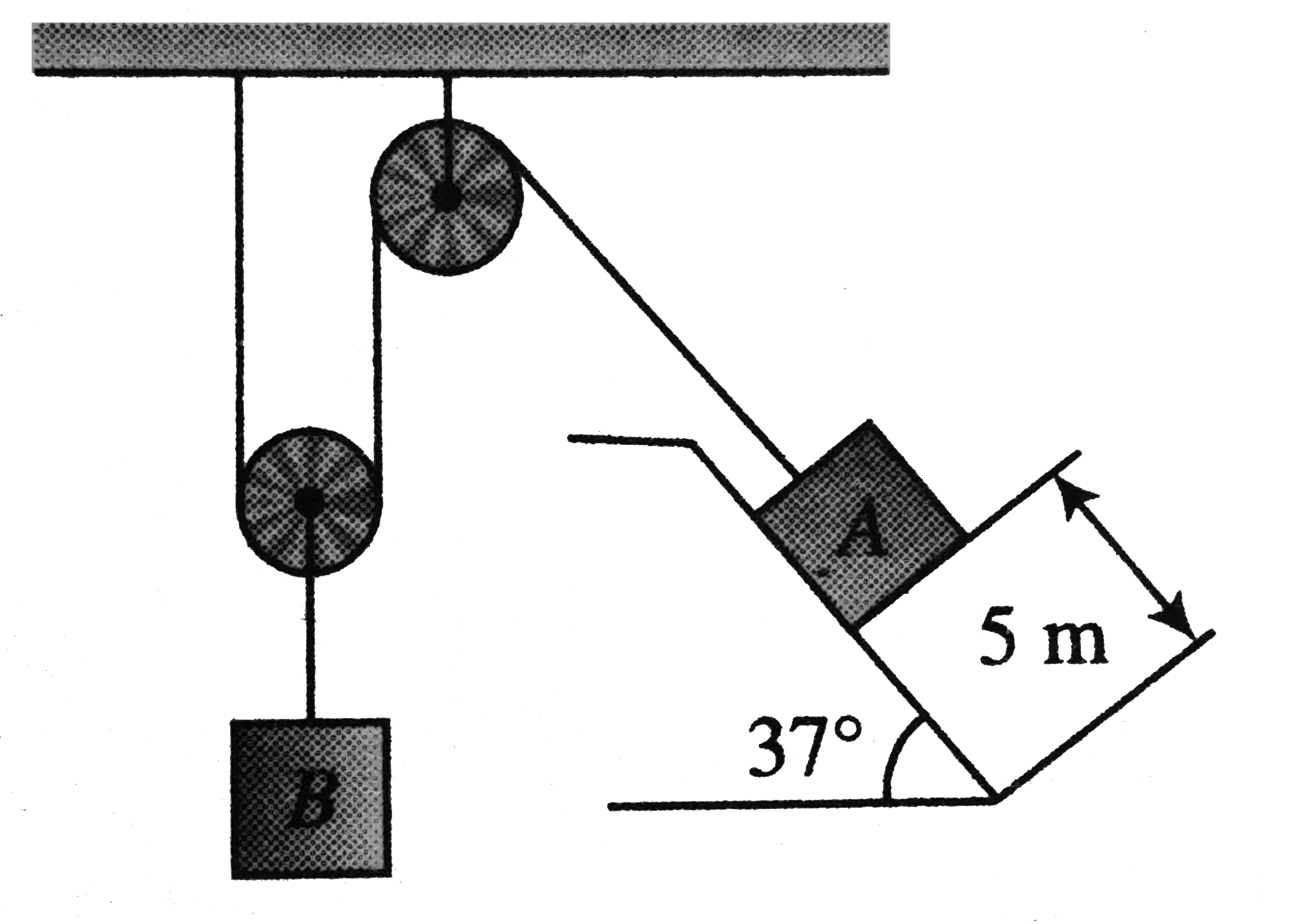 03:23View Solution
03:23View SolutionA collar `B` of mass `2kg` is constrained to move along horizontal smooth and fixed circular track of radius 5 m and having spring constant `200Nm^(-1)` is underformed when the collar is at `A`. If the collar starts from rest at `B` the normal reaction exerted by the track on the collar when it passes through `A` is
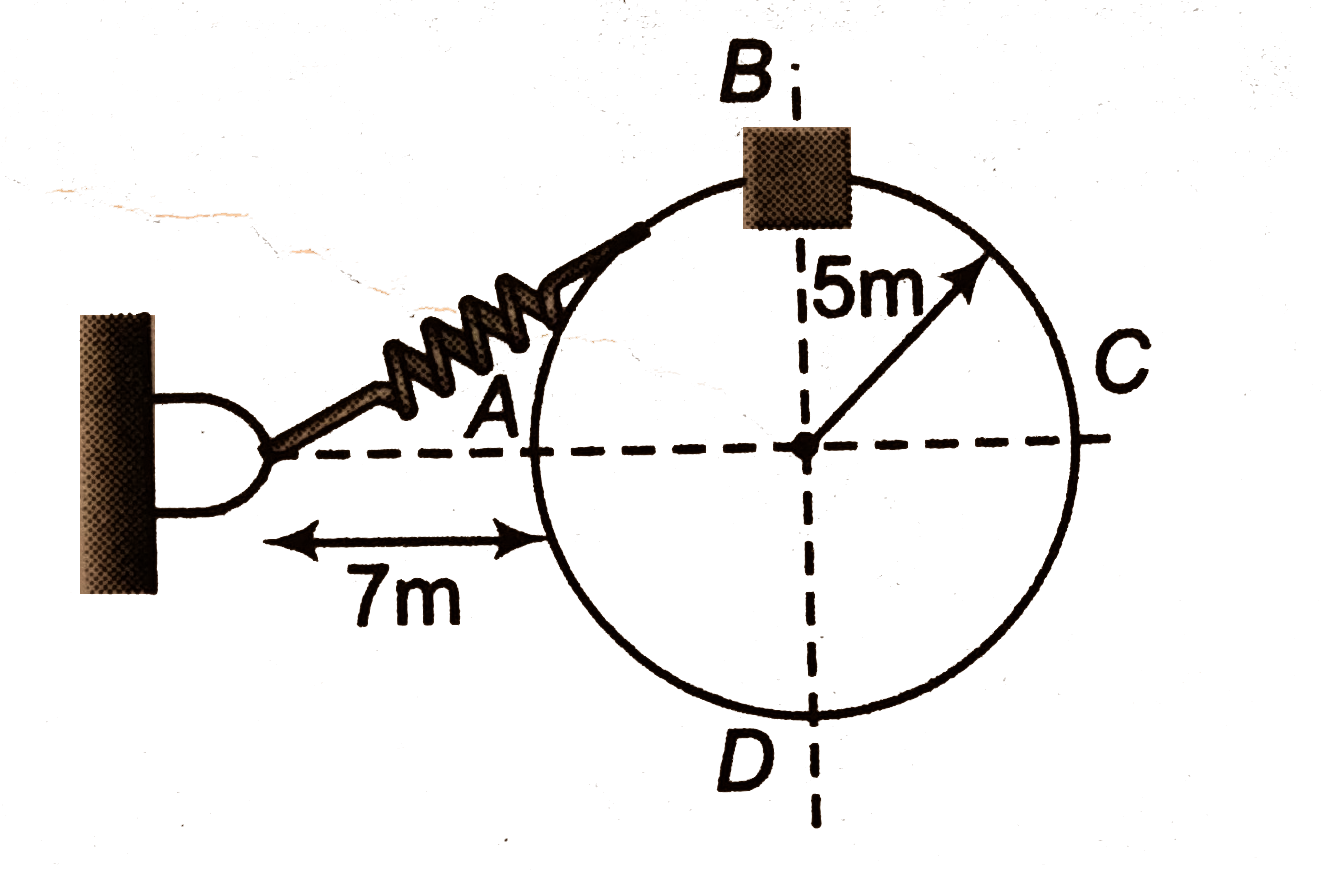 04:53View Solution
04:53View SolutionA block attached to a spring, pulled by a constant horizontal force, is kept on a smooth surface as shown in the figure. Initially, the spring is in the natural state. Then the maximum positive work that the applied force F can do is [Given that spring does not break]
 01:23View Solution
01:23View SolutionA particle is projected along a horizontal field whose coefficient of friction varies as `mu=A//r^2`, where r is the distance from the origin in meters and A is a positive constant. The initial distance of the particle is `1m` from the origin and its velocity is radially outwards. The minimum initial velocity at this point so the particle never stops is
03:54View SolutionTwo identical blocks A and B are placed on two inclined planes as shown in figure. Neglect resistance and other friction.

Read the following statements and choose options.
Statement I: The kinetic energy of A on sliding to J will be greater than the kinetic of B on sliding to O.
Statement II: The acceleration of A will be greater than acceleration of B when both are released on the inclined plane.
Statement III: The work done by external agent to move the block slowly from position B to O is negative.05:40View SolutionA block of mass `m` is being pulled up a rough incline by an agent delivering constant power P. The coefficient of friction between the block and the incline is `mu`. The maximum speed of the block during the course of ascent is
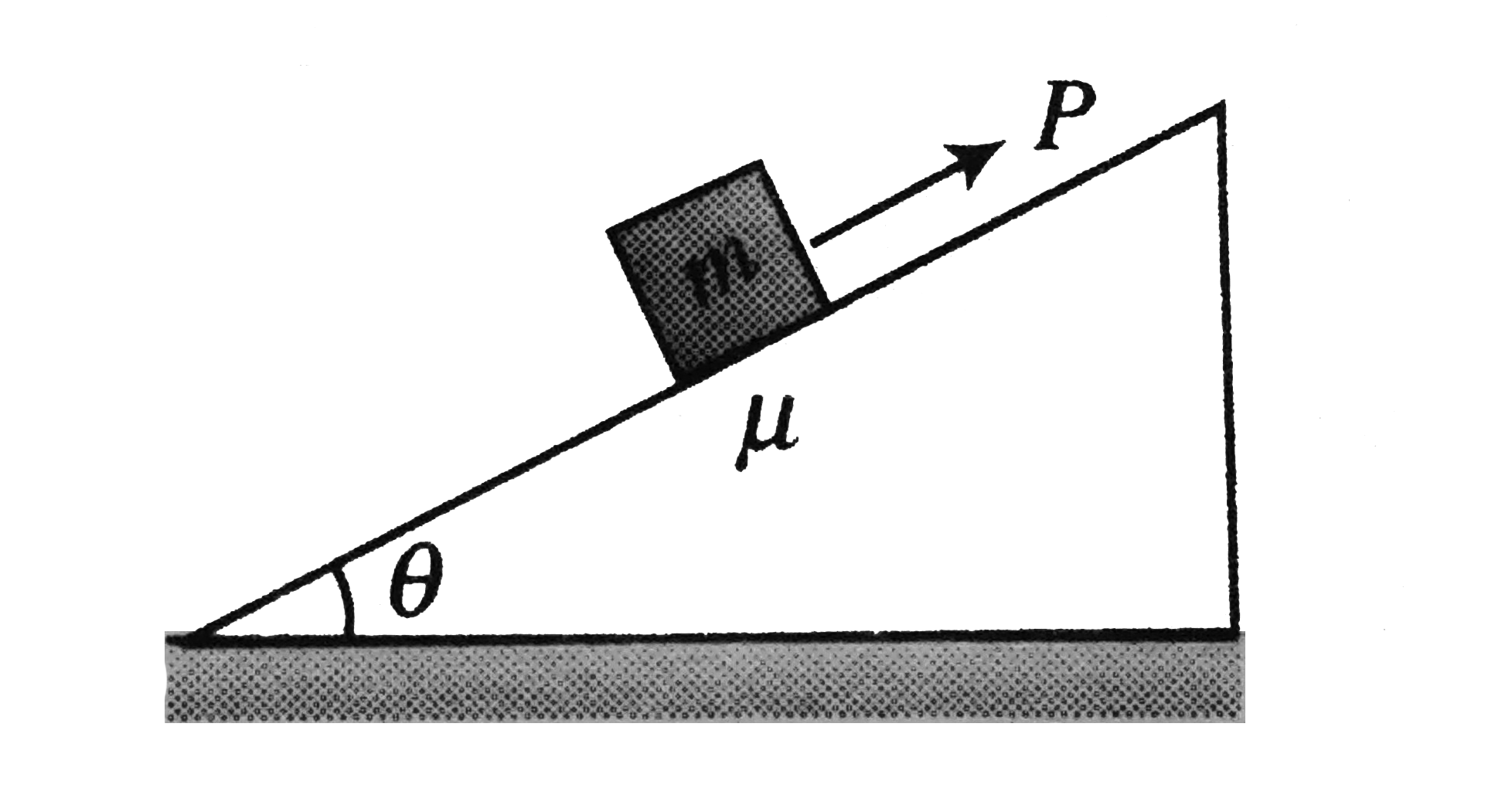 04:06View Solution
04:06View SolutionThe given plot shows the variation of U, the potential energy of interaction between two particles with the distance separating them r,
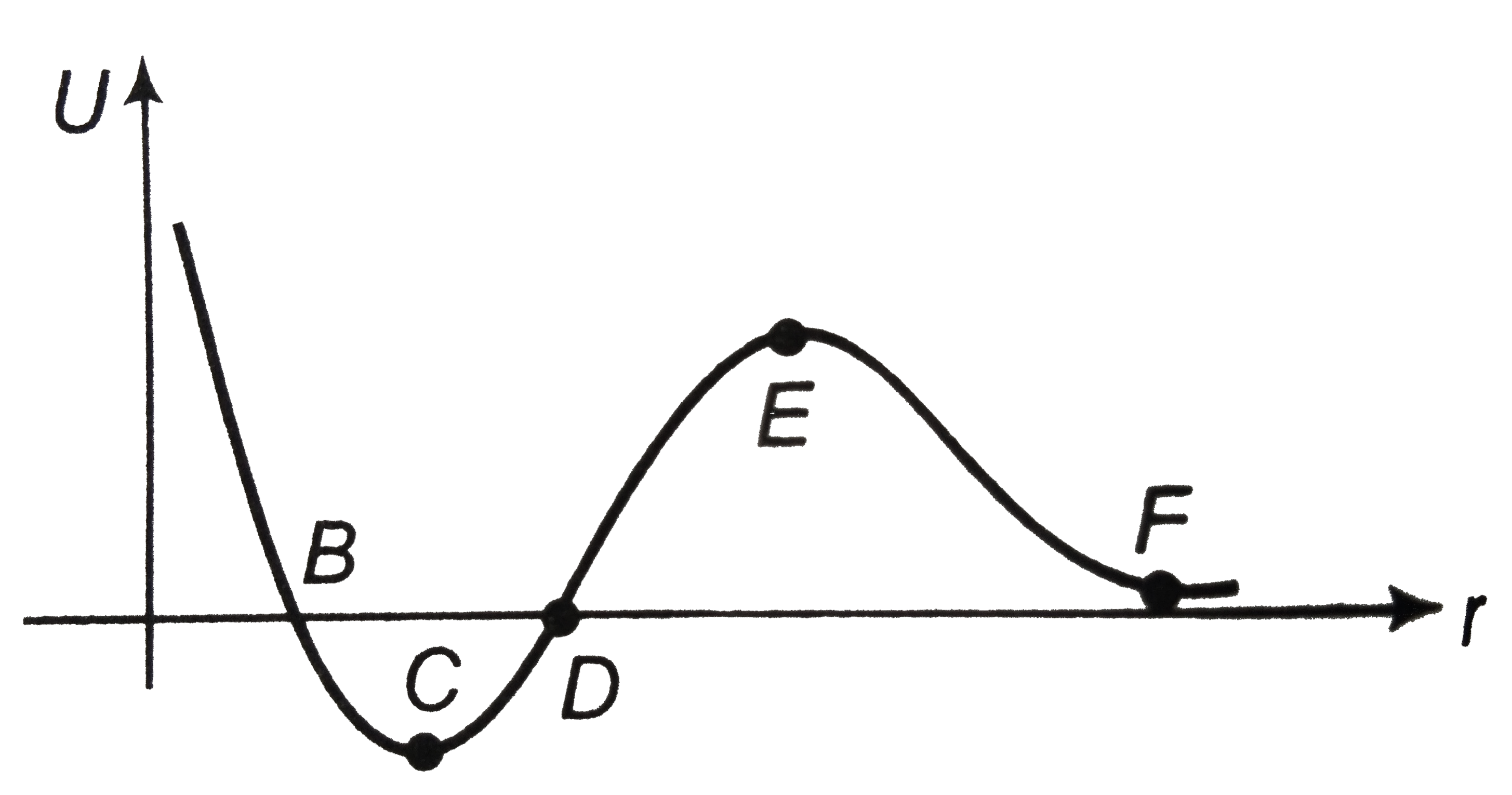 02:36View Solution
02:36View SolutionOne end of an unstretched vertical spring is attached to the ceiling and an object attached to the other end is slowly lowered to its equilibrium position. If S is the gain in spring energy and G is the loss in gravitational potential energy in the process, then
05:51View SolutionThe potential energy function associated with the force `vecF=4xyhati+2x^2hatj` is
02:15View SolutionThe potential energy for a force filed `vecF` is given by `U(x,y)=cos(x+y)`. The force acting on a particle at position given by coordinates `(0, pi//4)` is
01:54View SolutionA particle is projected with a velocity `u` making an angle `theta` with the horizontal. The instantaneous power of the gravitational force
02:59View SolutionA block of mass m is attached with a massless spring of force constant k. The block is placed over a rough inclined surface for which the coefficient of friction is `mu=(3)/(4)`. The minimum value of M required to move the block up the plane is (Neglect mass of string, mass of pulley and friction in pulley)
 04:21View Solution
04:21View SolutionIn the above question, the average power delivered by gravity is
02:07View SolutionA particle A of mass `10//7kg` is moving in the positive direction of x-axis. At initial position `x=0`, its velocity is `1ms^-1`, then its velocity at `x=10m` is (use the graph given)
 02:49View Solution
02:49View SolutionA particle is projected vertically upwards with a speed of `16ms^-1`. After some time, when it again passes through the point of projection, its speed is found to be `8ms^-1`. It is known that the work done by air resistance is same during upward and downward motion. Then the maximum height attained by the particle is (take `g=10ms^-2`)
04:17View SolutionAn engine can pull four coaches at a maximum speed of `20ms^-1`. The mass of the engine is twice the mass of every coach. Assuming resistive forces to be proportional to the weight, approximate maximum speeds of the engine, when it pulls `12` and `6` coaches, are
04:19View SolutionIn figure, the variation of potential energy of a particle of mass `m=2kg` is represented w.r.t its x-coordinate. The particle moves under the effect of the conservative force along the x-axis. Which of the following statements is incorrect about the particle?
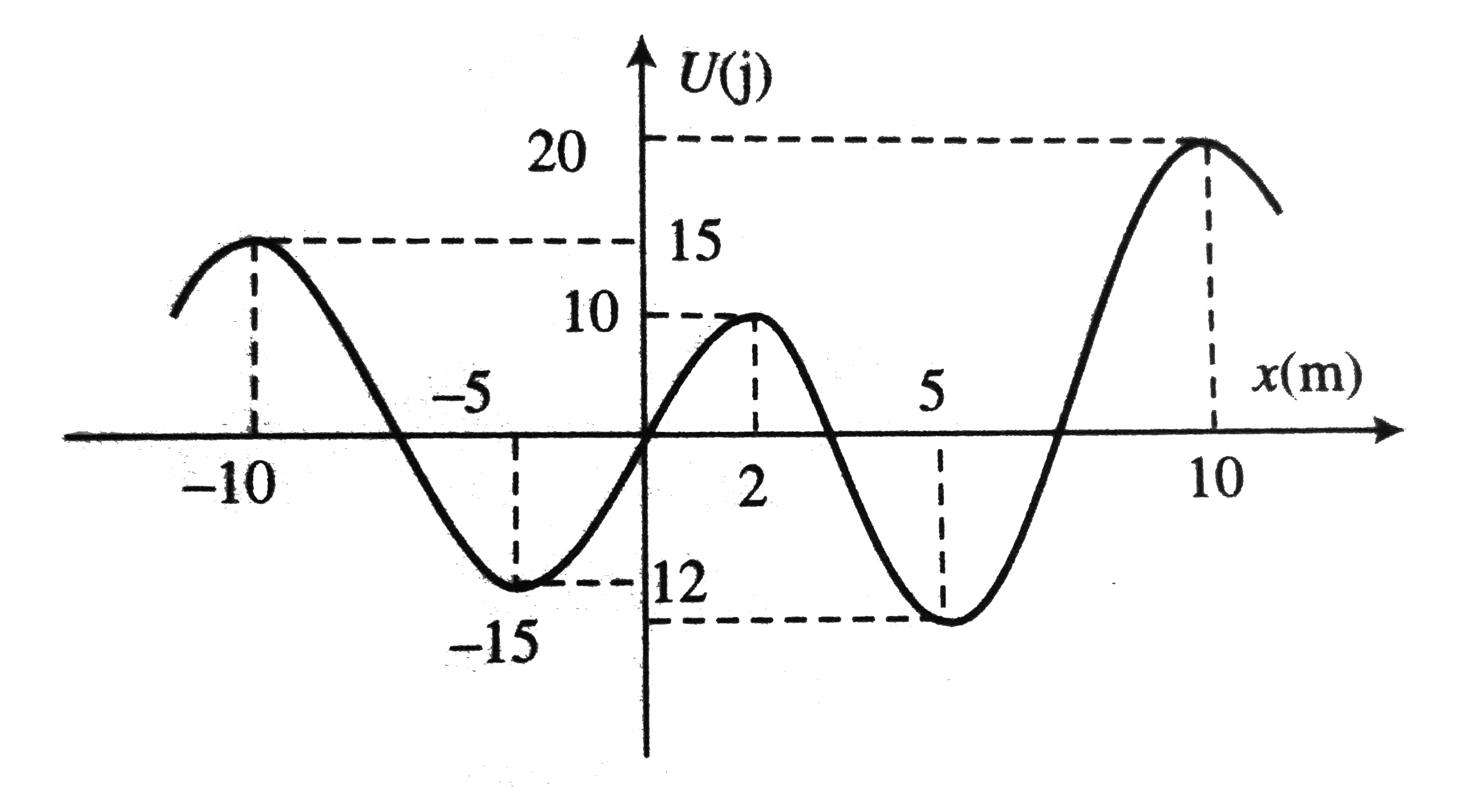 07:17View Solution
07:17View SolutionBlock `A` is hanging from vertical spring of spring constant `K` and is rest. Block `B` strikes block `A` with velocity `v` and sticks to it. Then the value of `v` for which the spring just attains natural length is
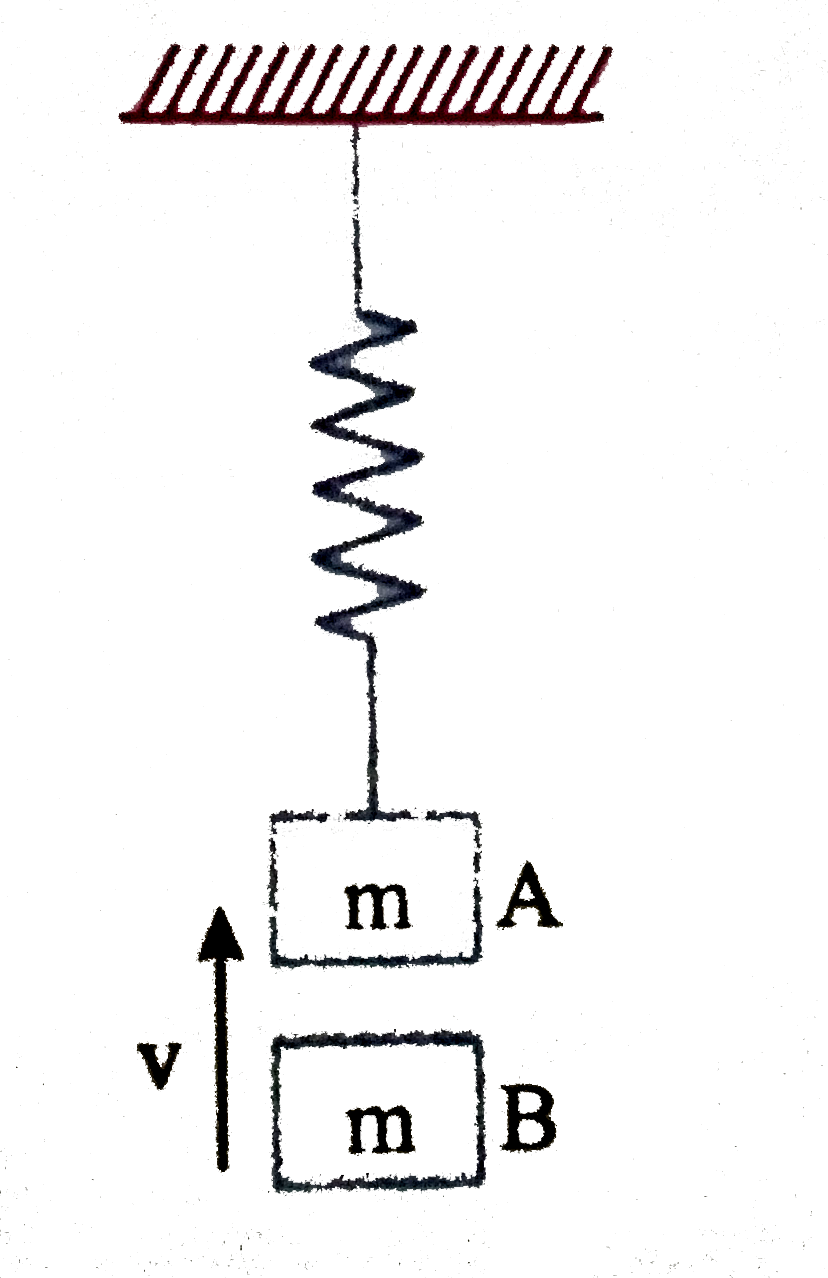 06:38View Solution
06:38View SolutionA machine delivers power to a body which is proportional to velocity of the body. If the body starts with a velocity which is almost negligible, then the distance covered by the body is proportional to
03:56View SolutionThe kinetic energy acquired by a mass `m` travelling a certain distance d, starting from rest, under the action of a force F such that the force F is directly proportional to t is
03:09View SolutionA particle of mass m slides on a frictionaless surface ABCD, starting from rest as shown in figure. The part BCD is a circular arc. If it looses contact at point P, the maximum height attained by the particle from point C is
 09:05View Solution
09:05View SolutionA projectile is fired with some velocity making certain angle with the horizontal. Which of the following graphs is the best representation for the kinetic energy of a projectile (KE) versus its horizontal displacement(x)?
06:16View SolutionTwo constant forces `vecF_1` and `vecF_2` act on a body of mass `8kg`. These forces displace the body from point `P(1, -2, 3)` to `Q` `(2, 3, 7)` in `2s` starting from rest. Force `vecF_1` is of magnitude `9N` and is acting along vector `(2hati-2hatj+hatk)`. Work done by the force `vecF_2` is
07:38View SolutionGiven `vecF=(xy^2)hati+(x^2y)hatjN`. The work done by `vecF` when a particle is taken along the semicircular path OAB where the coordinates of B are `(4,0)` is
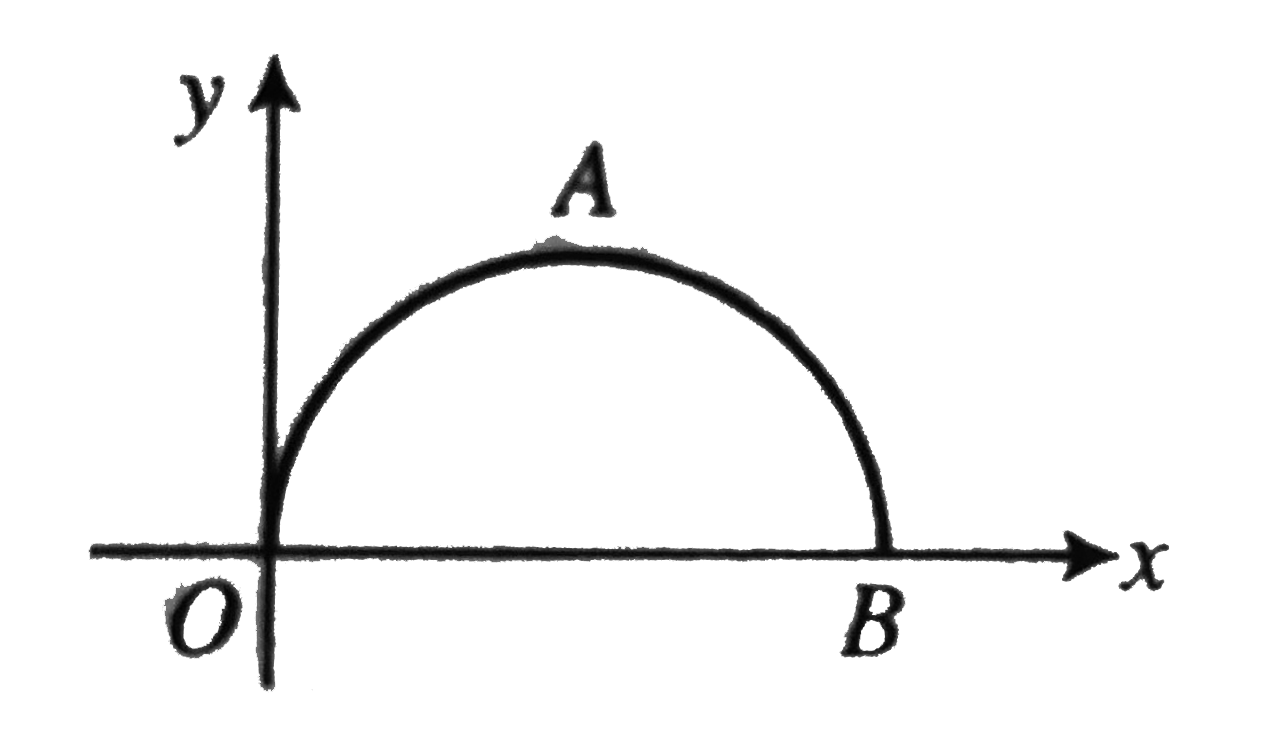 02:28View Solution
02:28View SolutionA force `vecF=(3xy-5z)hatj+4zhatk` is applied on a particle. The work done by the force when the particle moves from point `(0, 0, 0)` to point `(2, 4, 0)` as shown in figure.
 05:27View Solution
05:27View SolutionThe potential energy of a particle is determined by the expression `U=alpha(x^(2)+y^(2))`, where `alpha` is a positive constant. The particle begins to move from a point with the co-ordinates (3, 3) only under the action of potential fields force. When it reaches the point
(1, 1) its kinetic energy is `4 Kalpha`. Find the value of K.01:47View SolutionIn the position shown in figure, the spring is at its natural length. The block of mass `m` is given a velocity `v_0` towards the vertical support at `t=0`. The coefficient of friction between the block and the surface is given by `mu=alphax`, where `alpha` is a positive constant and x is the position of the block from its starting position. The block comes to rest for the first time at x, which is
 02:29View Solution
02:29View SolutionIn the figure shown, a spring of spring constant `K` is fixed at on end and the other end is attached to the mass 'm' . The coefficient of friction between block and the inclined plane is `mu`. The block is released when the spring is in tis natural length. Assuming that the `theta gt mu`, the maximum speed of the block during the motion is.
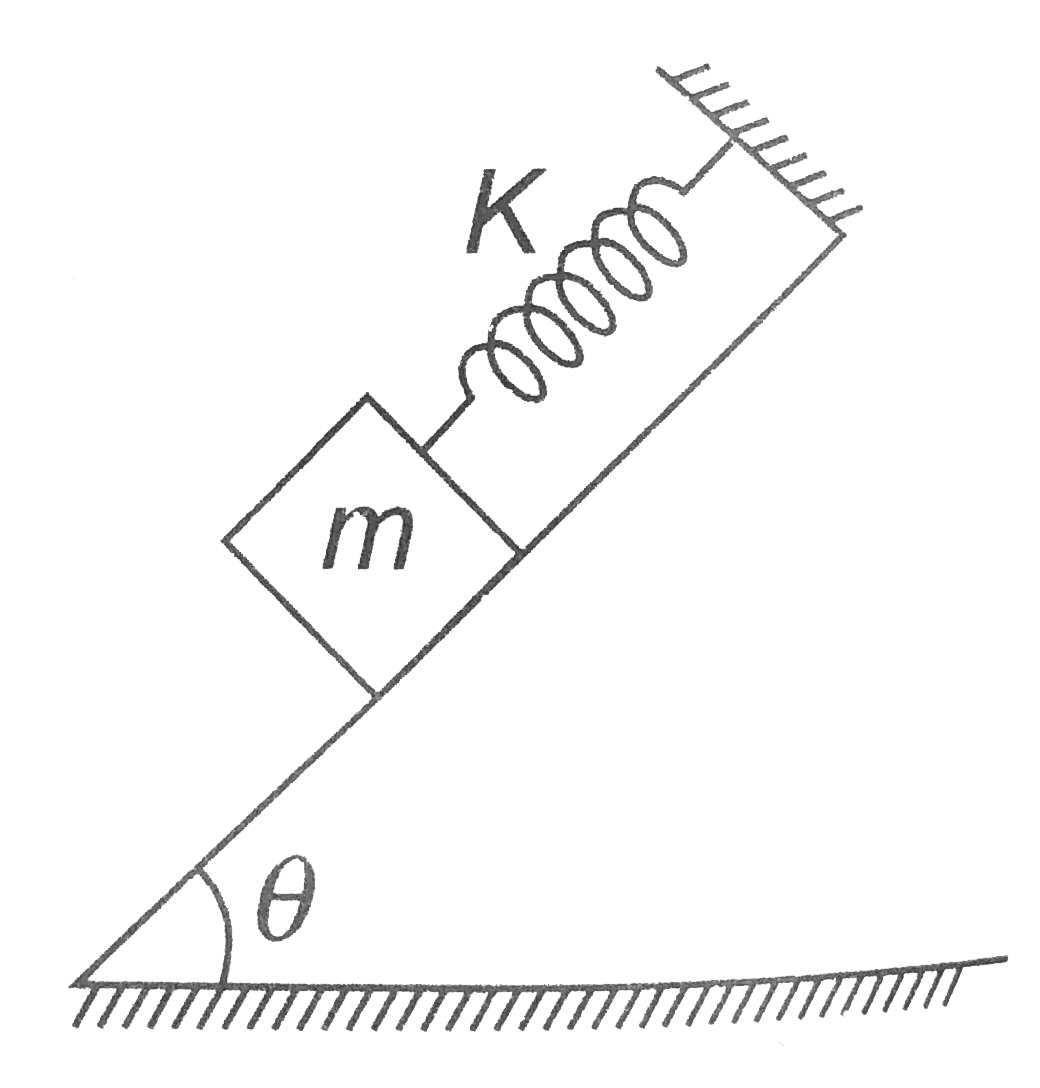 05:12View Solution
05:12View SolutionLet `r` be the distance of a particle from a fixed point to which it is attracted by an inverse square law force given by `F=k//r^2` (k=constant). Let m be the mass of the particle and L be its angular momentum with respect to the fixed point. Which of the following formulae is correct about the total energy of the system?
05:19View SolutionA mass m starting from A reaches B of a frictionless track. On reaching B, it pushes the track with a force equal to x times its weight, then the applicable relation is
 04:45View Solution
04:45View SolutionA particle of mass `m` slides along a curved-flat-curved track. The curved portions of the track are smooth. If the particle is released at the top of one of the curved portions, the particle comes to rest at flat portion of length l and of `mu=mu_(ki n etic)` after covering a distance of
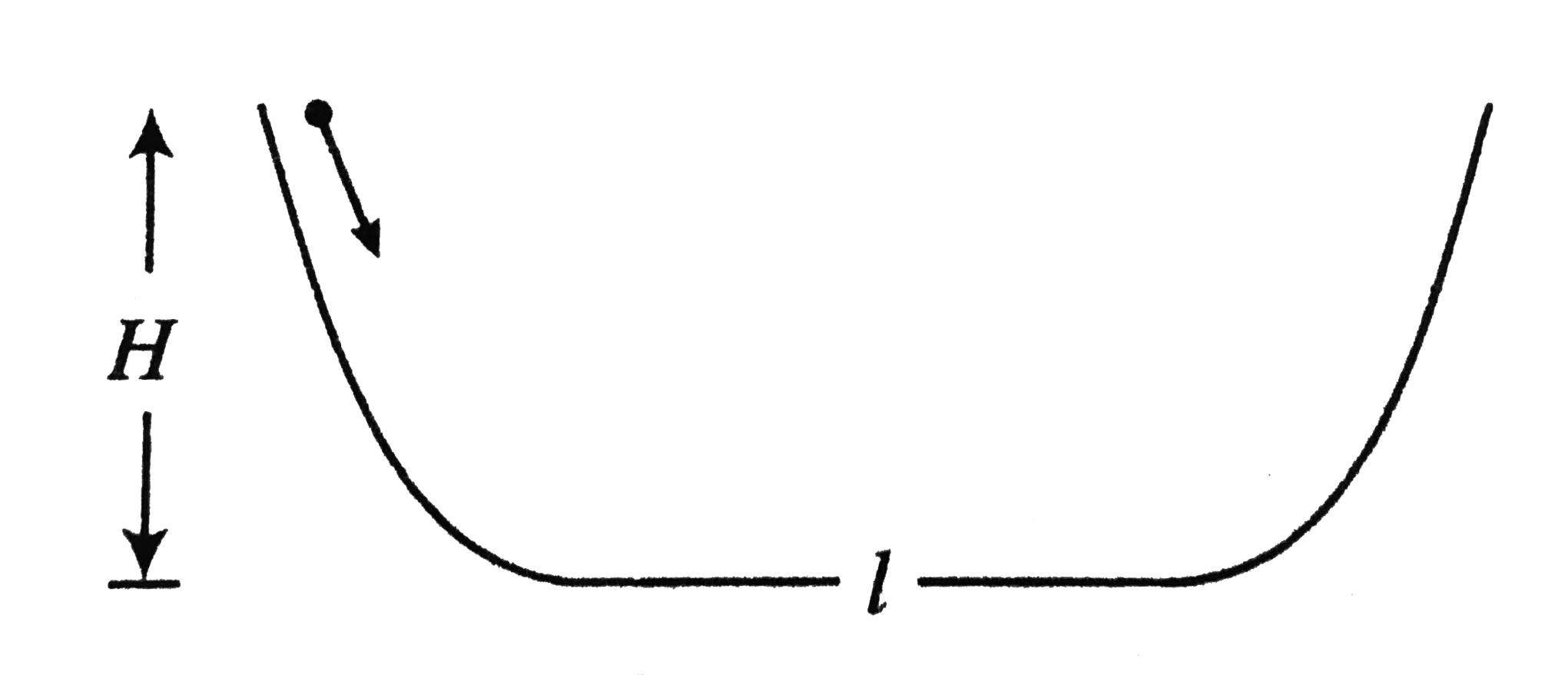 03:48View Solution
03:48View SolutionA block of mass `m` has initial velocity `u` having direction towards `+x` axis. The block stops after covering a distnce S causing similar extension in the spring of constant K holding it. If `mu` is the kinetic friction between the block and the surface on which it was moving, the distance S is given
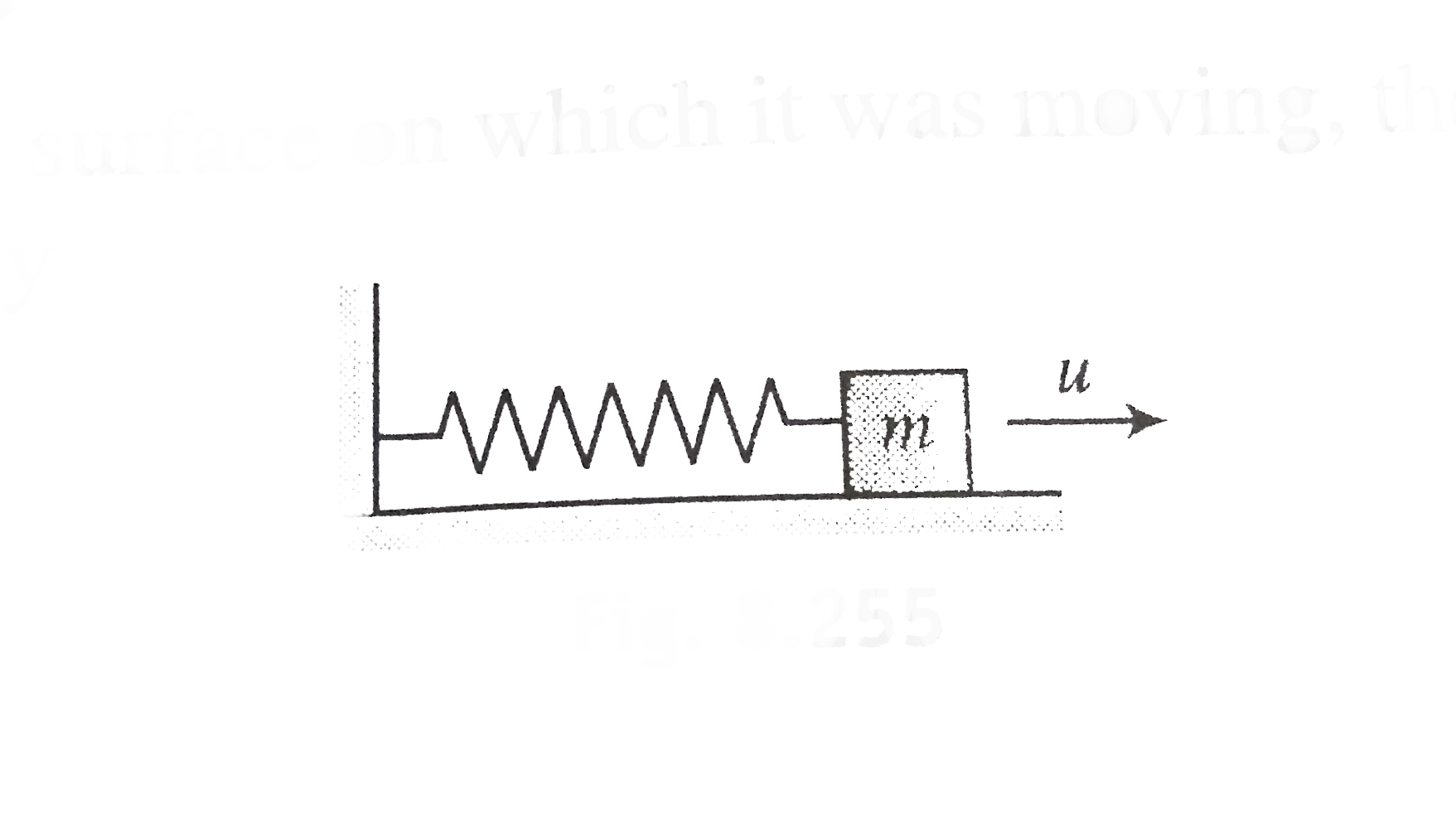 05:13View Solution
05:13View SolutionA moving railway compartment has a spring of constant k fixed to its front wall. A boy stretches this spring by distance x and in the mean time the compartment moves by a distance s. The work done by boy w.r.t. earth is
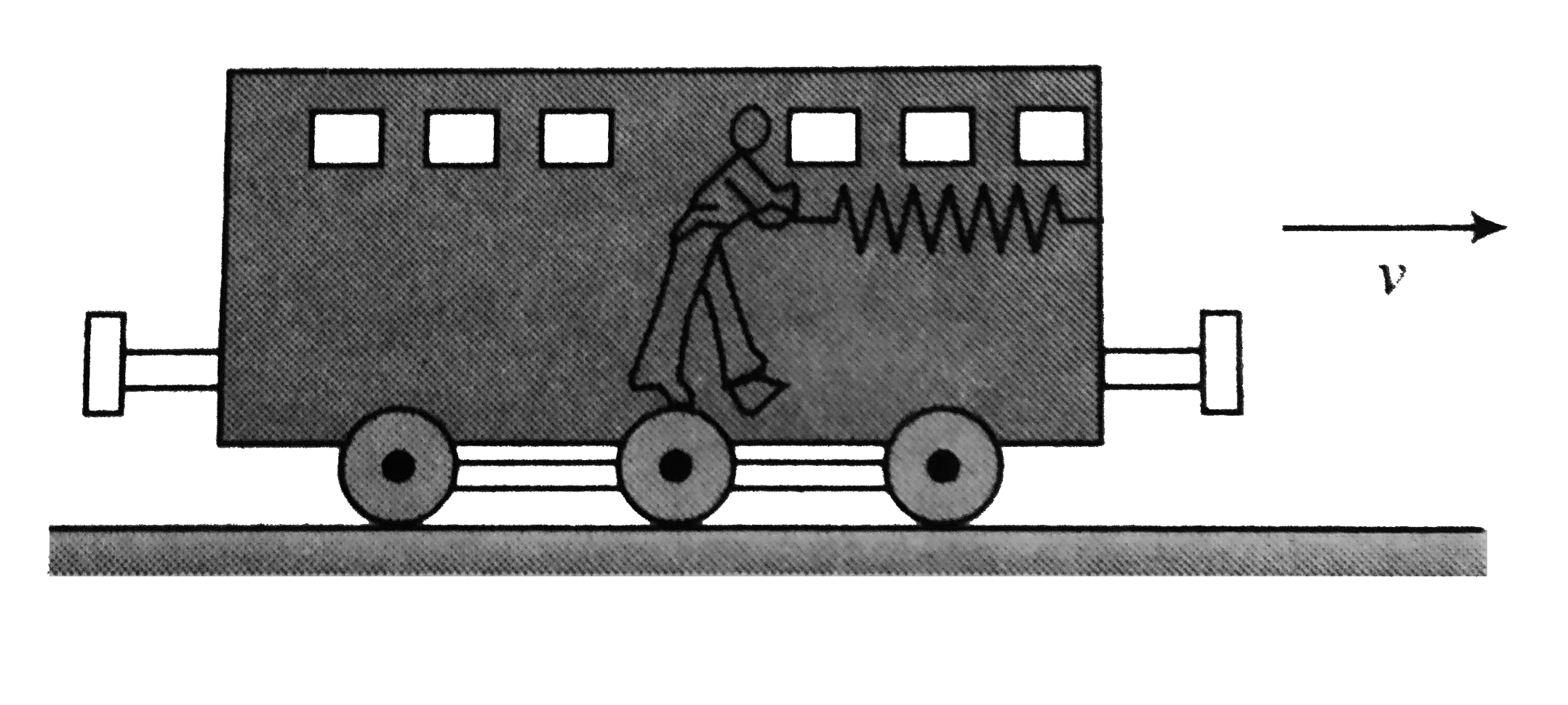 03:25View Solution
03:25View SolutionA rope ladder of length L is attached to a balloon of mass M. As the man of mass m climbs the ladder into the balloon basket, the balloon comes down by a vertical distance s. Then the increase in potential energy of man divided by the increase in potential energy of balloon is
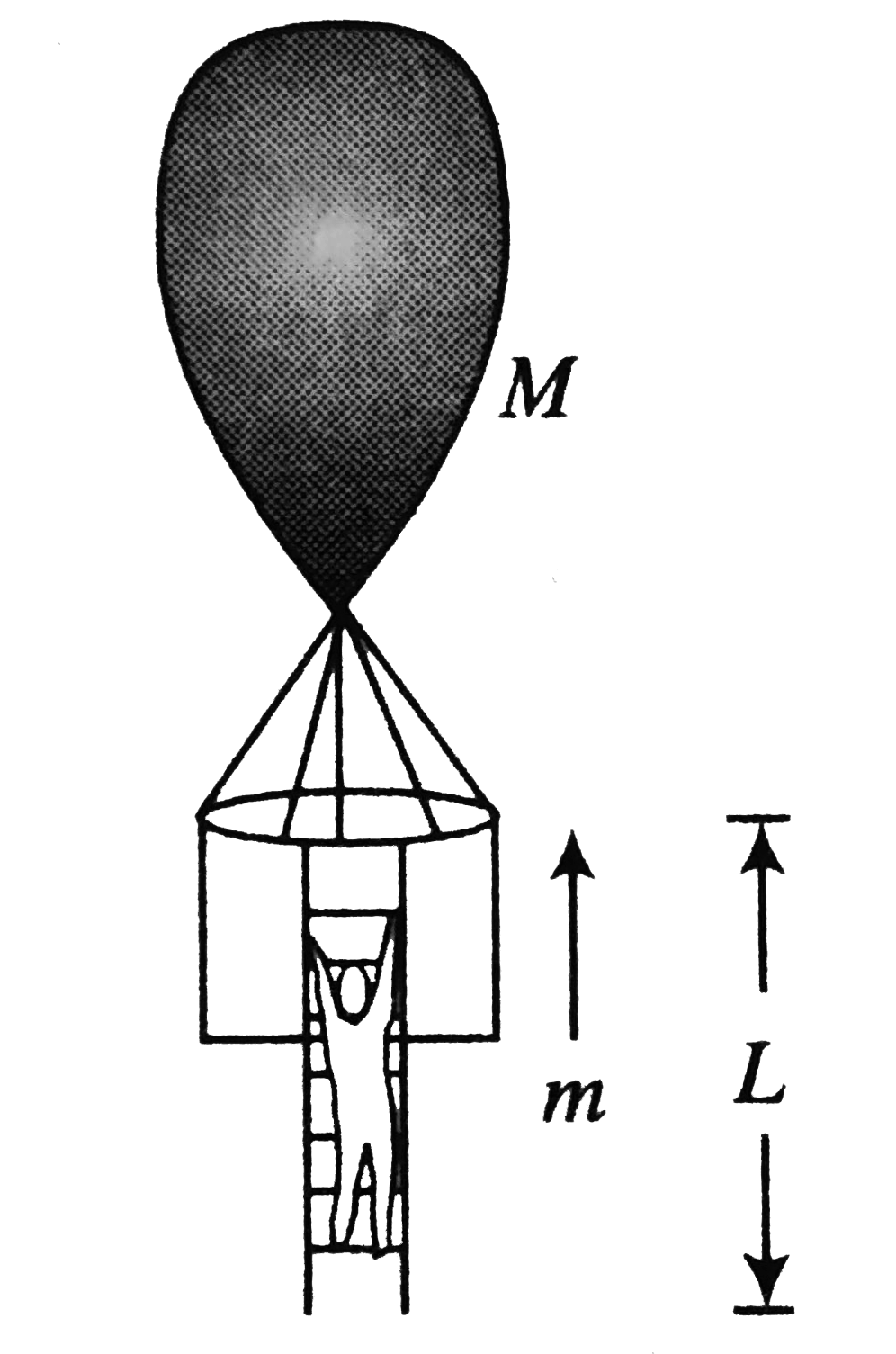 03:13View Solution
03:13View SolutionA block of mass `m` is lying at rest at point P of a wedge having a smooth semi-circular track of radius R. What should be the minimum value of `a_0` so that the mass can just reach point Q
 01:28View Solution
01:28View SolutionFigure shows a smooth vertical circular track AB of radius R. A block slides along the surface AB when it is given a velocity equal to `sqrt(6gR)` at point A. The ratio of the force exerted by the track on the block at point A to that at point B is
 05:45View Solution
05:45View SolutionA bead of mass m is released from rest at A to move along the fixed smooth circular track as shown in figure. The ratio of magnitudes of centripetal force and normal reaction by the track on the bead at any point `P_0` described by the angle `theta(!=0)` would
 03:04View Solution
03:04View SolutionA simple pendulum consisting of a mass M attached to a string of length L is released from rest at an angle `alpha`. A pin is located at a distance l below the pivot point. When the pendulum swings down, the string hits the pin as shown in figure. The maximum angle `theta` which the string makes with the vertical after hitting the pin is
 03:33View Solution
03:33View SolutionTwo bodies of masses `m` and `4m` are attached to a light string as shown in figure. A body of mass m hanging from string is executing oscillations with angular amplitude `60^@`, while other body is at rest on a horizontal surface. The minimum coefficient of friction between mass `4m` and the horizontal surface is (here pulley is light and smooth)
 03:28View Solution
03:28View SolutionA `500-kg` car, moving with a velocity of `36kmh^-1` on a straight road unidirectionally, doubles its velocity in `1min`. The average power delivered by the engine for doubling the velocity is
02:49View SolutionTwo spring P and Q having stiffness constants `k_1` and `k_2(ltk_1)`, respectively are stretched equally. Then
03:08View SolutionIn the above question, if equal forces are applied on two springs, then
03:39View SolutionWater is drawn from a well in a `5kg` drum of capacity `55L` by two ropes connected to the top of the drum. The linear mass density of each rope is `0.5kgm^-1`. The work done in lifting water to the ground from the surface of water in the well `20m` below is
`[g=10ms^-2]`03:33View SolutionA bead of mass `1/2 kg` starts from rest from A to move in a vertical place along a smooth fixed quarter ring of radius `5 m`, under the action of a constant horizontal force `f=5 N` as shown. The speed of bead as it reaches the point (B) is [Take `g=10 ms^(-2)`]
 05:12View Solution
05:12View SolutionA block of mass `m` is connected to a spring of spring constant k as shown in figure. The frame in which the block is placed is given an acceleration a towards left. Neglect friction between the block and the frame walls. The maximum velocity of the block relative to the frame is
 03:17View Solution
03:17View SolutionFigure shows a plot of the potential energy as a function of `x` for a particle moving along the x-axis. Which of the following statement(s) is/are true?
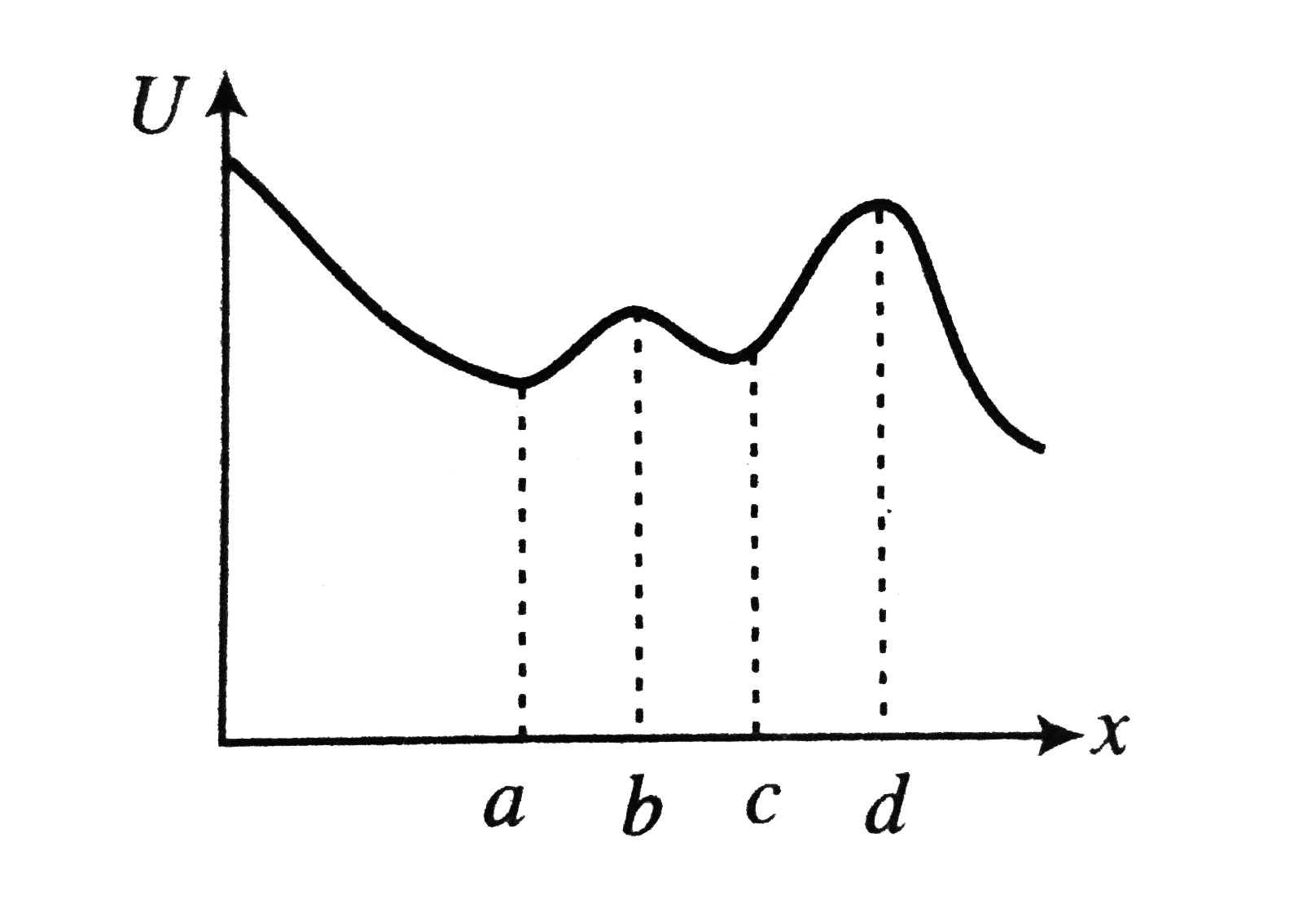 04:20View Solution
04:20View SolutionA `20-kg` block attached to a spring of spring constant `5Nm^-1` is released from rest at A. The spring at this instant is having an elongation of `1m`. The block is allowed to move in smooth horizontal slot with the help of a constant force `50N` in the rope as shown. The velocity of the block as it reaches B is (assume the rope to be light)
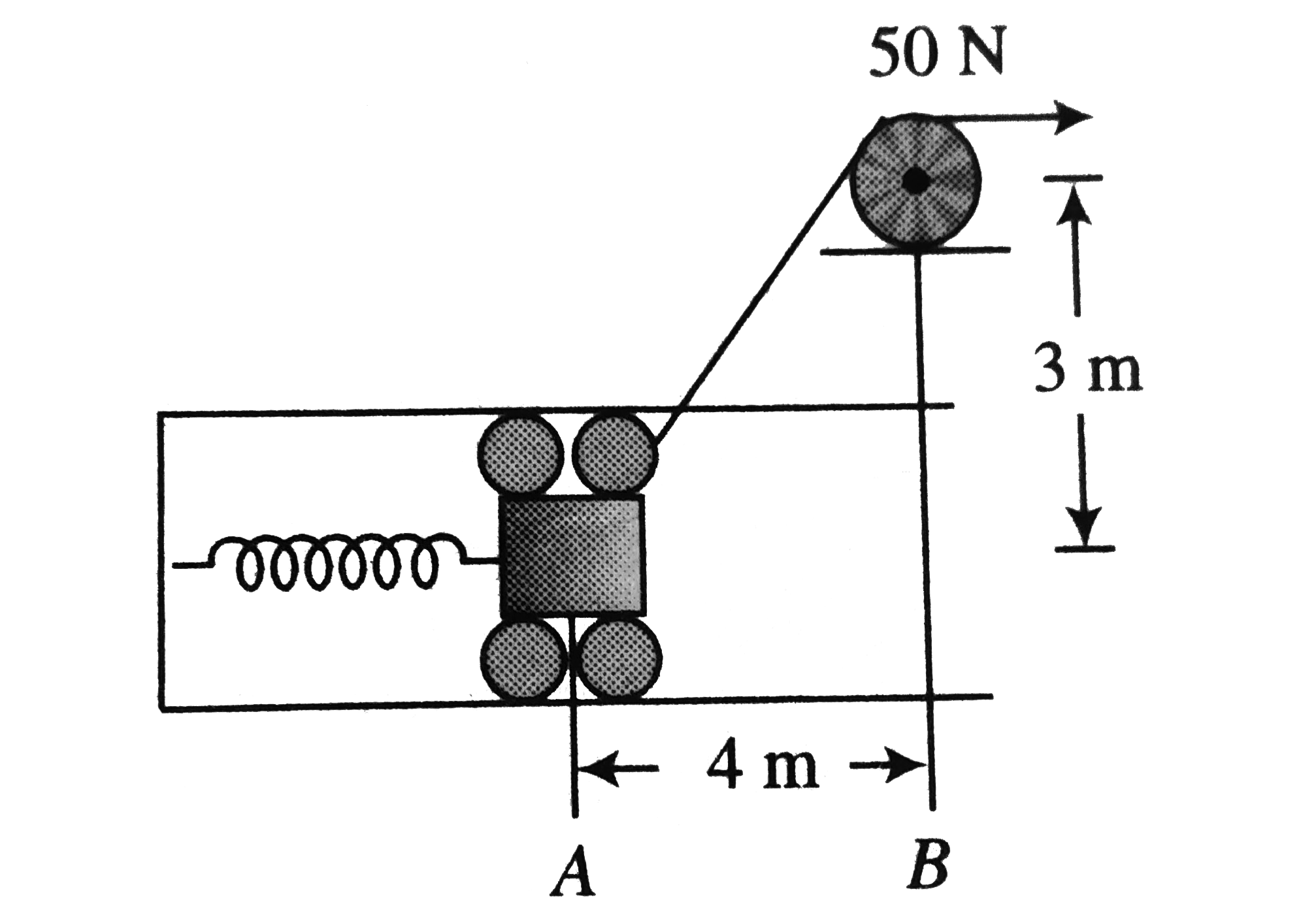 04:34View Solution
04:34View SolutionTwo identical blocks, each having mass M, are placed as shown in figure. These two blocks A and B are smoothly conjugated, so that when another block C of mass m passes from A to B there is no jerk. All the surfaces are frictionless, and all three blocks are free to move. Block C is released from rest, then
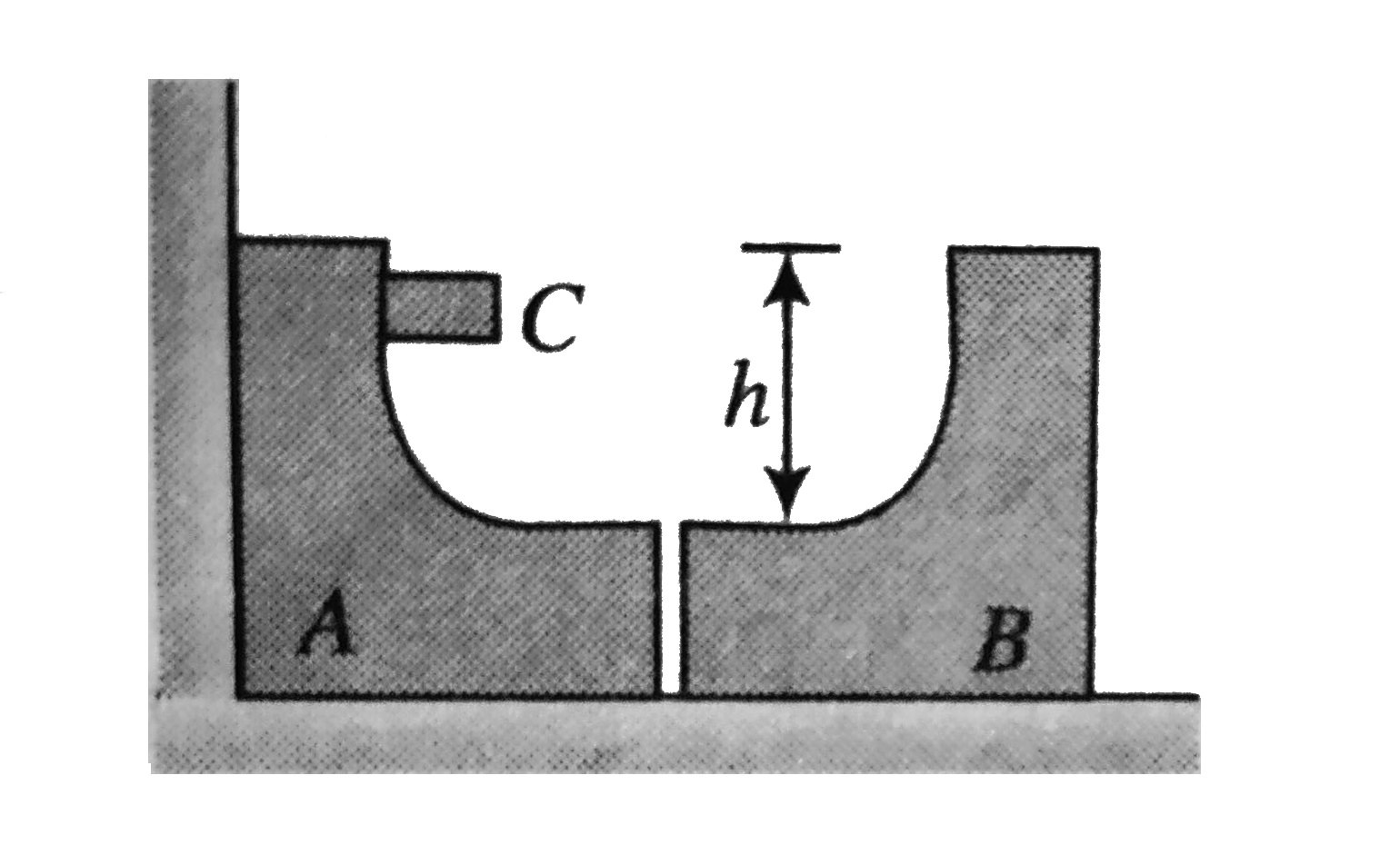 03:40View Solution
03:40View SolutionA `1kg` stone at the end of `1m` long string is whirled in a vertical circle at a constant speed of `4m//s`. The tension in the string is `6N`, when the stone is at `(g=10m//s^(2))`
03:34View SolutionA 1 kg stone at the end of 1 m long string is whirled in a vertical circle at constant speed of 4 m/sec. The tension in the string is 6 N when the stone is at `(g =10m//sec^(2))`
04:22View SolutionBall A of mass m, after sliding from an inclined plane, strikes elastically another ball B of same mass at rest. Find the minimum heihgt h so that ball B just completes the circular motion of the surface at C. (All surfaces are smooth).
 05:09View Solution
05:09View SolutionA ball of mass `m` is released from A inside a smooth wedge of mass `m` as shown in figure. What is the speed of the wedge when the ball reaches point B?
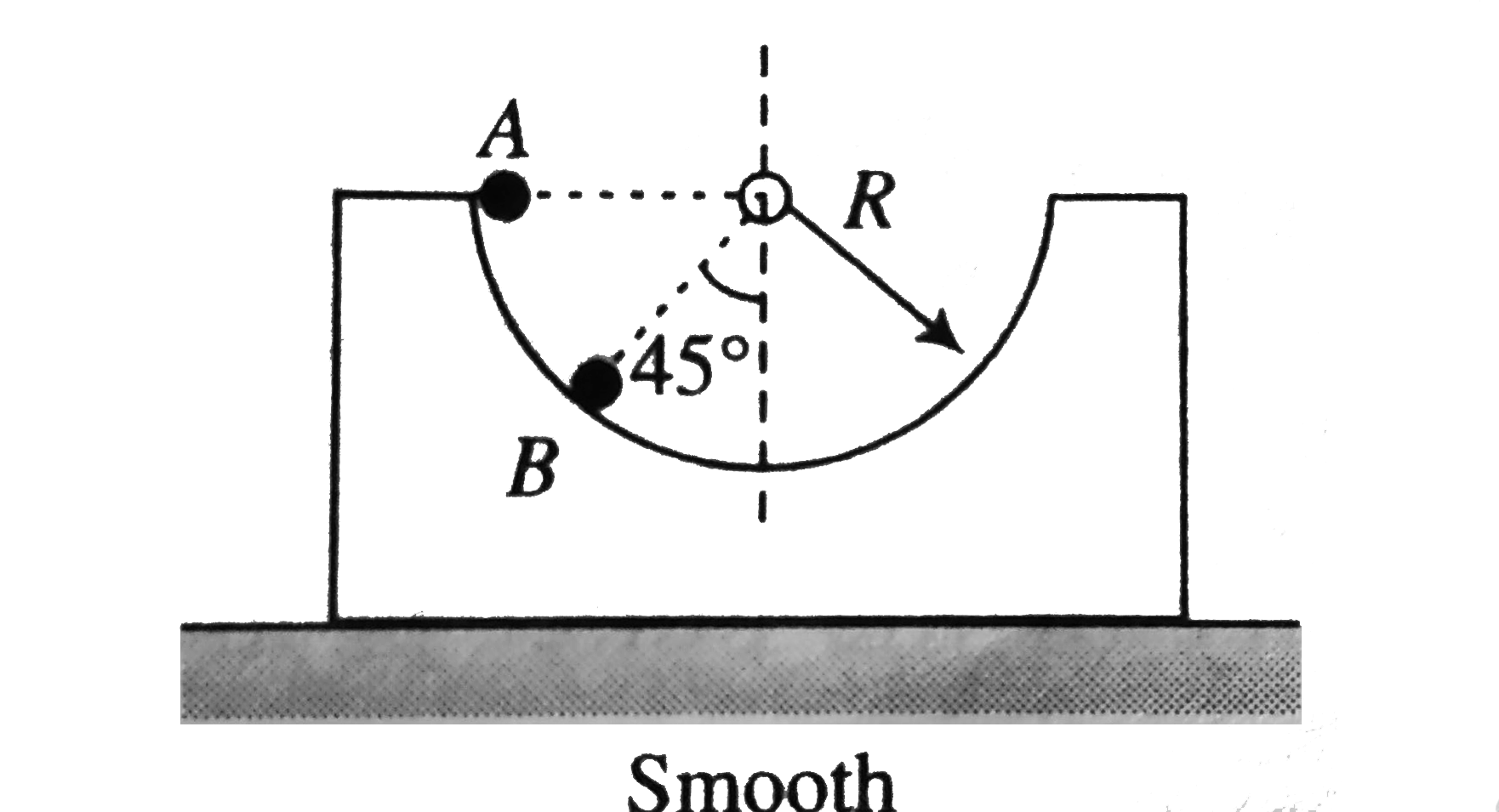 05:48View Solution
05:48View SolutionA small sphere is given vertical velocity of magnitude `v_0=5ms^-1` and it swings in a vertical plane about the end of a massless string. The angle `theta` with the vertical at which string will break, knowing that it can withstand a maximum tension equal to twice the weight of the sphere, is
 05:53View Solution
05:53View SolutionIn the figure, block A is released from rest when the spring is its natural length for the block B of mass m to leave contact with the ground at some stage what should be the minimum mass of block A?
 . 03:54View Solution
. 03:54View SolutionA block of mass `5.0kg` slides down from the top of an inclined plane of length `3m`. The first `1m` of the plane is smooth and the next `2m` is rough. The block is released from rest and again comes to rest at the bottom of the plane. If the plane is inclined at `30^@` with the horizontal, find the coefficient of friction on the rough portion.
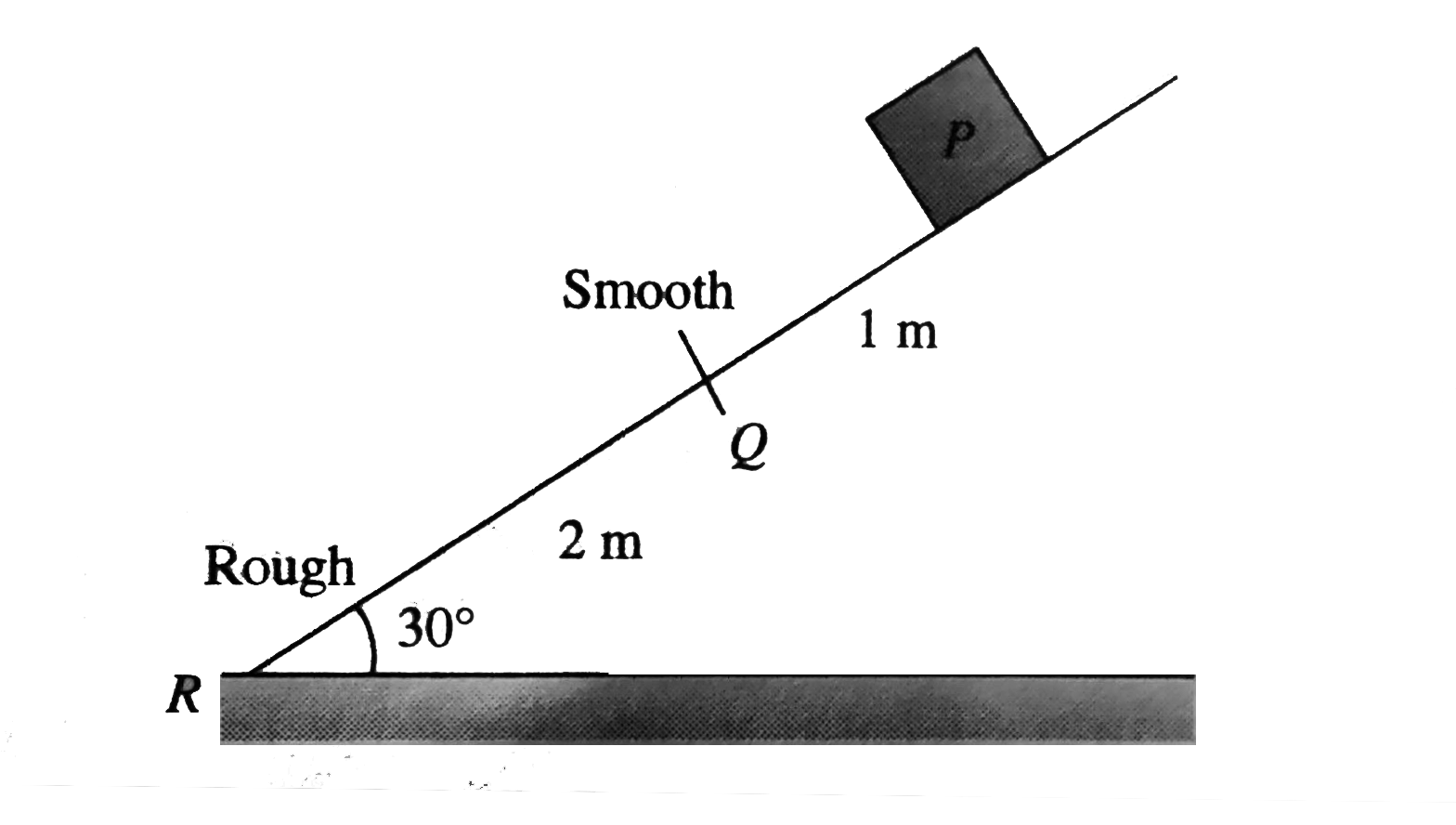 06:00View Solution
06:00View Solution
Single Correct questions and complete solutions for chapter WORK, POWER & ENERGY of CENGAGE PHYSICS (ENGLISH) of Class 11
